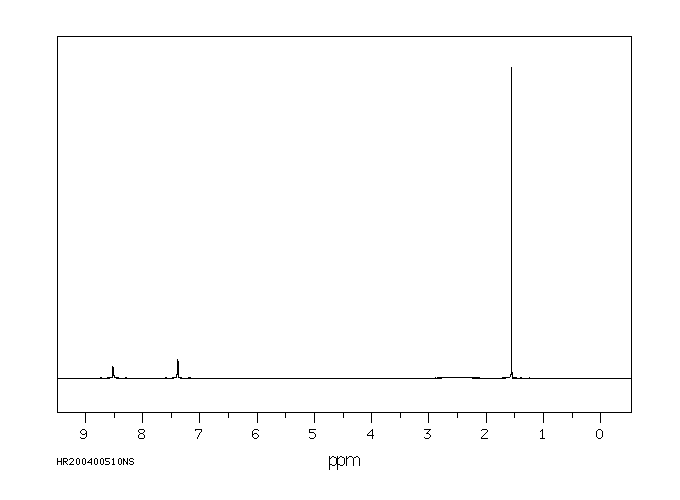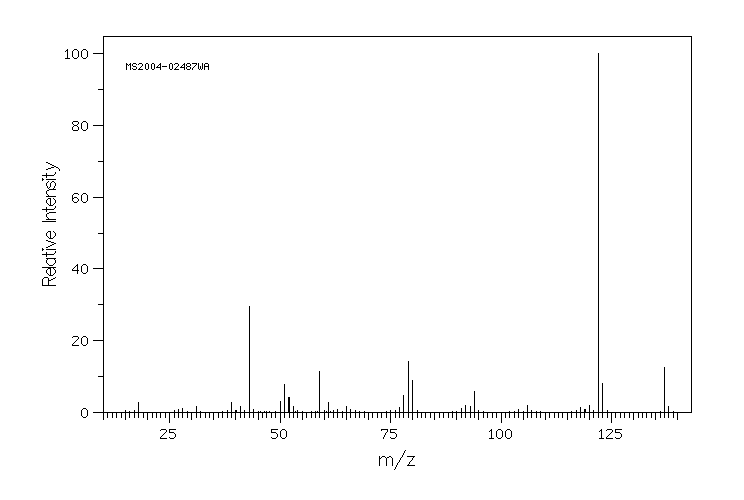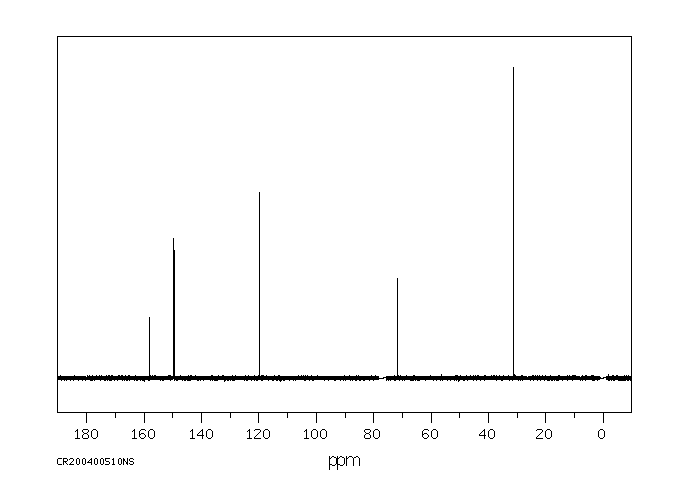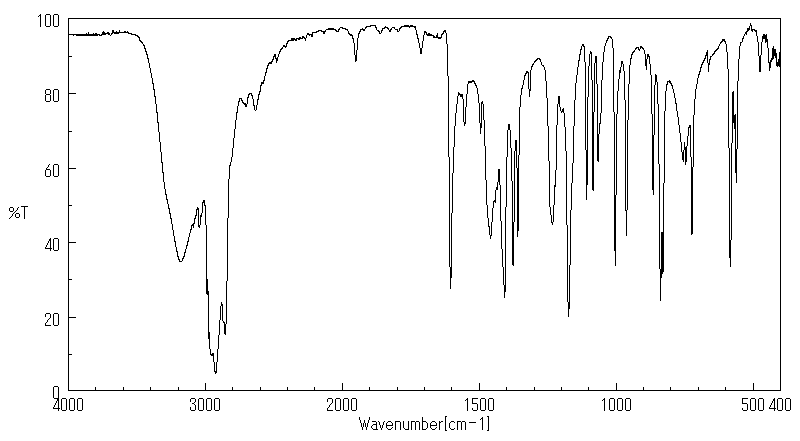2-(4-吡啶基)-2-丙醇 | 15031-78-4
中文名称
2-(4-吡啶基)-2-丙醇
中文别名
2-(4-吡啶基)-异丙醇;2-(4-吡啶)-2-丙醇
英文名称
2-(4-pyridyl)propan-2-ol
英文别名
2-(4-pyridyl)-2-propanol;2-(pyridin-4-yl)propan-2-ol;2-pyridin-4-ylpropan-2-ol
CAS
15031-78-4
化学式
C8H11NO
mdl
MFCD00071746
分子量
137.181
InChiKey
WEQVCDIJDUVSID-UHFFFAOYSA-N
BEILSTEIN
——
EINECS
——
-
物化性质
-
计算性质
-
ADMET
-
安全信息
-
SDS
-
制备方法与用途
-
上下游信息
-
文献信息
-
表征谱图
-
同类化合物
-
相关功能分类
-
相关结构分类
物化性质
-
熔点:136 °C
-
沸点:140 °C / 3mmHg
-
密度:1.052±0.06 g/cm3(Predicted)
-
溶解度:溶于甲醇
计算性质
-
辛醇/水分配系数(LogP):0.6
-
重原子数:10
-
可旋转键数:1
-
环数:1.0
-
sp3杂化的碳原子比例:0.375
-
拓扑面积:33.1
-
氢给体数:1
-
氢受体数:2
安全信息
-
危险等级:IRRITANT
-
危险品标志:Xi
-
危险类别码:R36/37/38
-
海关编码:2933399090
-
危险类别:IRRITANT
-
安全说明:S26
-
危险性防范说明:P305+P351+P338
-
危险性描述:H315,H319
-
储存条件:室温且干燥
SDS
2-(4-吡啶基)-2-丙醇 修改号码:5
模块 1. 化学品
产品名称: 2-(4-Pyridyl)-2-propanol
修改号码: 5
模块 2. 危险性概述
GHS分类
物理性危害 未分类
健康危害
皮肤腐蚀/刺激 第2级
严重损伤/刺激眼睛 2A类
环境危害 未分类
GHS标签元素
图标或危害标志
信号词 警告
危险描述 造成皮肤刺激
造成严重眼刺激
防范说明
[预防] 处理后要彻底清洗双手。
穿戴防护手套/护目镜/防护面具。
[急救措施] 眼睛接触:用水小心清洗几分钟。如果方便,易操作,摘除隐形眼镜。继续冲洗。
眼睛接触:求医/就诊
皮肤接触:用大量肥皂和水轻轻洗。
若皮肤刺激:求医/就诊。
脱掉被污染的衣物,清洗后方可重新使用。
模块 3. 成分/组成信息
单一物质/混和物 单一物质
化学名(中文名): 2-(4-吡啶基)-2-丙醇
百分比: >97.0%(GC)(T)
CAS编码: 15031-78-4
俗名: 2-(4-Pyridyl)isopropyl Alcohol
2-(4-吡啶基)-2-丙醇 修改号码:5
模块 3. 成分/组成信息
分子式: C8H11NO
模块 4. 急救措施
吸入: 将受害者移到新鲜空气处,保持呼吸通畅,休息。若感不适请求医/就诊。
皮肤接触: 立即去除/脱掉所有被污染的衣物。用大量肥皂和水轻轻洗。
若皮肤刺激或发生皮疹:求医/就诊。
眼睛接触: 用水小心清洗几分钟。如果方便,易操作,摘除隐形眼镜。继续清洗。
如果眼睛刺激:求医/就诊。
食入: 若感不适,求医/就诊。漱口。
紧急救助者的防护: 救援者需要穿戴个人防护用品,比如橡胶手套和气密性护目镜。
模块 5. 消防措施
合适的灭火剂: 干粉,泡沫,雾状水,二氧化碳
特殊危险性: 小心,燃烧或高温下可能分解产生毒烟。
特定方法: 从上风处灭火,根据周围环境选择合适的灭火方法。
非相关人员应该撤离至安全地方。
周围一旦着火:如果安全,移去可移动容器。
消防员的特殊防护用具: 灭火时,一定要穿戴个人防护用品。
模块 6. 泄漏应急处理
个人防护措施,防护用具, 使用个人防护用品。远离溢出物/泄露处并处在上风处。
紧急措施: 泄露区应该用安全带等圈起来,控制非相关人员进入。
环保措施: 防止进入下水道。
控制和清洗的方法和材料: 清扫收集粉尘,封入密闭容器。注意切勿分散。附着物或收集物应该立即根据合适的
法律法规处置。
模块 7. 操作处置与储存
处理
技术措施: 在通风良好处进行处理。穿戴合适的防护用具。防止粉尘扩散。处理后彻底清洗双手
和脸。
注意事项: 如果粉尘或浮质产生,使用局部排气。
操作处置注意事项: 避免接触皮肤、眼睛和衣物。
贮存
储存条件: 保持容器密闭。存放于凉爽、阴暗处。
远离不相容的材料比如氧化剂存放。
包装材料: 依据法律。
模块 8. 接触控制和个体防护
工程控制: 尽可能安装封闭体系或局部排风系统,操作人员切勿直接接触。同时安装淋浴器和洗
眼器。
个人防护用品
呼吸系统防护: 防尘面具。依据当地和政府法规。
手部防护: 防护手套。
眼睛防护: 安全防护镜。如果情况需要,佩戴面具。
皮肤和身体防护: 防护服。如果情况需要,穿戴防护靴。
模块 9. 理化特性
外形(20°C): 固体
外观: 晶体-粉末
2-(4-吡啶基)-2-丙醇 修改号码:5
模块 9. 理化特性
颜色: 极淡的黄色-浅红黄色
气味: 无资料
pH: 无数据资料
熔点:
136°C
沸点/沸程 140 °C/0.4kPa
闪点: 无资料
爆炸特性
爆炸下限: 无资料
爆炸上限: 无资料
密度: 无资料
溶解度:
[水] 无资料
[其他溶剂]
溶于: 甲醇
模块 10. 稳定性和反应性
化学稳定性: 一般情况下稳定。
危险反应的可能性: 未报道特殊反应性。
须避免接触的物质 氧化剂
危险的分解产物: 一氧化碳, 二氧化碳, 氮氧化物 (NOx)
模块 11. 毒理学信息
急性毒性: 无资料
对皮肤腐蚀或刺激: 无资料
对眼睛严重损害或刺激: 无资料
生殖细胞变异原性: 无资料
致癌性:
IARC = 无资料
NTP = 无资料
生殖毒性: 无资料
模块 12. 生态学信息
生态毒性:
鱼类: 无资料
甲壳类: 无资料
藻类: 无资料
残留性 / 降解性: 无资料
潜在生物累积 (BCF): 无资料
土壤中移动性
log水分配系数: 无资料
土壤吸收系数 (Koc): 无资料
亨利定律 无资料
constaNT(PaM3/mol):
模块 13. 废弃处置
如果可能,回收处理。请咨询当地管理部门。建议在可燃溶剂中溶解混合,在装有后燃和洗涤装置的化学焚烧炉中
焚烧。废弃处置时请遵守国家、地区和当地的所有法规。
2-(4-吡啶基)-2-丙醇 修改号码:5
模块 14. 运输信息
联合国分类: 与联合国分类标准不一致
UN编号: 未列明
模块 15. 法规信息
《危险化学品安全管理条例》(2002年1月26日国务院发布,2011年2月16日修订): 针对危险化学品的安全使用、
生产、储存、运输、装卸等方面均作了相应的规定。
模块16 - 其他信息
N/A
模块 1. 化学品
产品名称: 2-(4-Pyridyl)-2-propanol
修改号码: 5
模块 2. 危险性概述
GHS分类
物理性危害 未分类
健康危害
皮肤腐蚀/刺激 第2级
严重损伤/刺激眼睛 2A类
环境危害 未分类
GHS标签元素
图标或危害标志
信号词 警告
危险描述 造成皮肤刺激
造成严重眼刺激
防范说明
[预防] 处理后要彻底清洗双手。
穿戴防护手套/护目镜/防护面具。
[急救措施] 眼睛接触:用水小心清洗几分钟。如果方便,易操作,摘除隐形眼镜。继续冲洗。
眼睛接触:求医/就诊
皮肤接触:用大量肥皂和水轻轻洗。
若皮肤刺激:求医/就诊。
脱掉被污染的衣物,清洗后方可重新使用。
模块 3. 成分/组成信息
单一物质/混和物 单一物质
化学名(中文名): 2-(4-吡啶基)-2-丙醇
百分比: >97.0%(GC)(T)
CAS编码: 15031-78-4
俗名: 2-(4-Pyridyl)isopropyl Alcohol
2-(4-吡啶基)-2-丙醇 修改号码:5
模块 3. 成分/组成信息
分子式: C8H11NO
模块 4. 急救措施
吸入: 将受害者移到新鲜空气处,保持呼吸通畅,休息。若感不适请求医/就诊。
皮肤接触: 立即去除/脱掉所有被污染的衣物。用大量肥皂和水轻轻洗。
若皮肤刺激或发生皮疹:求医/就诊。
眼睛接触: 用水小心清洗几分钟。如果方便,易操作,摘除隐形眼镜。继续清洗。
如果眼睛刺激:求医/就诊。
食入: 若感不适,求医/就诊。漱口。
紧急救助者的防护: 救援者需要穿戴个人防护用品,比如橡胶手套和气密性护目镜。
模块 5. 消防措施
合适的灭火剂: 干粉,泡沫,雾状水,二氧化碳
特殊危险性: 小心,燃烧或高温下可能分解产生毒烟。
特定方法: 从上风处灭火,根据周围环境选择合适的灭火方法。
非相关人员应该撤离至安全地方。
周围一旦着火:如果安全,移去可移动容器。
消防员的特殊防护用具: 灭火时,一定要穿戴个人防护用品。
模块 6. 泄漏应急处理
个人防护措施,防护用具, 使用个人防护用品。远离溢出物/泄露处并处在上风处。
紧急措施: 泄露区应该用安全带等圈起来,控制非相关人员进入。
环保措施: 防止进入下水道。
控制和清洗的方法和材料: 清扫收集粉尘,封入密闭容器。注意切勿分散。附着物或收集物应该立即根据合适的
法律法规处置。
模块 7. 操作处置与储存
处理
技术措施: 在通风良好处进行处理。穿戴合适的防护用具。防止粉尘扩散。处理后彻底清洗双手
和脸。
注意事项: 如果粉尘或浮质产生,使用局部排气。
操作处置注意事项: 避免接触皮肤、眼睛和衣物。
贮存
储存条件: 保持容器密闭。存放于凉爽、阴暗处。
远离不相容的材料比如氧化剂存放。
包装材料: 依据法律。
模块 8. 接触控制和个体防护
工程控制: 尽可能安装封闭体系或局部排风系统,操作人员切勿直接接触。同时安装淋浴器和洗
眼器。
个人防护用品
呼吸系统防护: 防尘面具。依据当地和政府法规。
手部防护: 防护手套。
眼睛防护: 安全防护镜。如果情况需要,佩戴面具。
皮肤和身体防护: 防护服。如果情况需要,穿戴防护靴。
模块 9. 理化特性
外形(20°C): 固体
外观: 晶体-粉末
2-(4-吡啶基)-2-丙醇 修改号码:5
模块 9. 理化特性
颜色: 极淡的黄色-浅红黄色
气味: 无资料
pH: 无数据资料
熔点:
136°C
沸点/沸程 140 °C/0.4kPa
闪点: 无资料
爆炸特性
爆炸下限: 无资料
爆炸上限: 无资料
密度: 无资料
溶解度:
[水] 无资料
[其他溶剂]
溶于: 甲醇
模块 10. 稳定性和反应性
化学稳定性: 一般情况下稳定。
危险反应的可能性: 未报道特殊反应性。
须避免接触的物质 氧化剂
危险的分解产物: 一氧化碳, 二氧化碳, 氮氧化物 (NOx)
模块 11. 毒理学信息
急性毒性: 无资料
对皮肤腐蚀或刺激: 无资料
对眼睛严重损害或刺激: 无资料
生殖细胞变异原性: 无资料
致癌性:
IARC = 无资料
NTP = 无资料
生殖毒性: 无资料
模块 12. 生态学信息
生态毒性:
鱼类: 无资料
甲壳类: 无资料
藻类: 无资料
残留性 / 降解性: 无资料
潜在生物累积 (BCF): 无资料
土壤中移动性
log水分配系数: 无资料
土壤吸收系数 (Koc): 无资料
亨利定律 无资料
constaNT(PaM3/mol):
模块 13. 废弃处置
如果可能,回收处理。请咨询当地管理部门。建议在可燃溶剂中溶解混合,在装有后燃和洗涤装置的化学焚烧炉中
焚烧。废弃处置时请遵守国家、地区和当地的所有法规。
2-(4-吡啶基)-2-丙醇 修改号码:5
模块 14. 运输信息
联合国分类: 与联合国分类标准不一致
UN编号: 未列明
模块 15. 法规信息
《危险化学品安全管理条例》(2002年1月26日国务院发布,2011年2月16日修订): 针对危险化学品的安全使用、
生产、储存、运输、装卸等方面均作了相应的规定。
模块16 - 其他信息
N/A
上下游信息
反应信息
-
作为反应物:描述:参考文献:名称:离子/中性复合物在 N-苄基-(烷基吡啶鎓)离子碎裂中的作用摘要:摘要 研究了在吡啶核上带有烷基的 N-苄基吡啶鎓离子作为气态离子/中性复合物的潜在前体。I/N 复合物 [C 6 H 5 CH 2 + ... 烷基吡啶] 的出现是通过存在于邻-、间-和对-烷基(R = 甲基,乙基、异丙基和苄基)。在电离子笼质谱仪中进行的离子碰撞诱导解离表明,氢化物转移强烈依赖于氢化物转移的能量需求以及氢化物供体的位置。发现导致甲苯损失的氢化物转移仅发生在那些在吡啶环的邻位带有异丙基或苄基取代基的 N-苄基吡啶鎓离子,从而反映了 I/N 复合物的中介性。发现所有假定的氢化物供体烷基在间位和对位是非反应性的,甚至在邻位的甲基和乙基也是如此。对氢化物转移和简单裂解通道进行了密度泛函计算 (B3LYP/6-311+G/3d,2p)//(B3LYP/6-31+G(d)) 以帮助合理化这些观察结果。结果表明,从 3- 和 4- 异丙基- 以及从 3- 和 4- 苄基吡啶中性中提取的DOI:10.1016/j.ijms.2010.10.006
-
作为产物:参考文献:名称:Pyridyl-propan-2-yl esters of 1-adamantane carboxylates摘要:具有以下通式的化合物:##STR1## 其中R.sup.1和R.sup.2各自代表氢或1至4个碳原子的烷基;A代表--O--或--CR.sup.4 R.sup.5,其中R.sup.4和R.sup.5的定义与R.sup.1或R.sup.2相同;R.sup.3代表脱氢环戊基团;Py代表3-或4-吡啶基团,作为自由碱或其药用盐,对治疗依赖雄激素的,特别是前列腺癌有益。公开号:US05595995A1
文献信息
-
Highly Alkyl-Selective Addition to Ketones with Magnesium Ate Complexes Derived from Grignard Reagents作者:Manabu Hatano、Tokihiko Matsumura、Kazuaki IshiharaDOI:10.1021/ol047685i日期:2005.2.1A highly efficient alkyl-selective addition to ketones with magnesium ate complexes derived from Grignard reagents and alkyllithiums is described. The nucleophilicity of R in R3MgLi is remarkably increased compared to that of the original RLi or RMgX, while the basicity of R3MgLi is decreased. Furthermore, a highly R-selective addition to ketones is demonstrated using RMe2MgLi in place of R3MgLi. [reaction:
-
THIAZOLIDINONE COMPOUNDS AND USE THEREOF申请人:National Health Research Institutes公开号:US20170253569A1公开(公告)日:2017-09-07A pharmaceutical composition containing a compound of Formula (I) for treating an opioid receptor-associated condition. Also disclosed is a method for treating an opioid receptor-associated condition using such a compound. Further disclosed are two sets of thiazolidinone compounds of formula (I): (i) compounds each having an enantiomeric excess greater than 90% and (ii) compounds each being substituted with deuterium.
-
[EN] HPK1 INHIBITORS, PREPARATION METHOD AND APPLICATION THEREOF<br/>[FR] INHIBITEURS D'HPK1, PROCÉDÉ DE PRÉPARATION ET UTILISATION ASSOCIÉS申请人:ZHUHAI YUFAN BIOTECHNOLOGIES CO LTD公开号:WO2019206049A1公开(公告)日:2019-10-31Disclosed are HPK-1 inhibitors having a structure represented by Formula (X), pharmaceutical compositions comprising the HPK-1 inhibitors, methods of using the HPK-1 inhibitors, such as treating cancers, methods of preparing the HPK-1 inhibitors, and the synthetic intermediates.
-
Proton NMR and IR study of self-association in pyridylalkanols: open or cyclic dimers? higher polymers?作者:John S. Lomas、Alain Adenier、Christine CordierDOI:10.1002/poc.1056日期:2006.5The IR spectra of 3-(X-pyridyl)-2,2,4,4-tetramethylpentan-3-ols (X = 3 or 4) in carbon tetrachloride suggest weak association, while the 2-pyridyl derivative occurs mainly as the intramolecularly hydrogen-bonded rotamer. The OH NMR shifts for the 3- and 4-pyridyl derivatives in benzene are concentration-dependent, but neither the equilibrium constants nor the degree of association can be evaluated1 H NMR测量表明,通式为(C 5 H 4 N)(CH 2)n OH的(X-吡啶基)烷醇,其中n = 1、2或3,它们自缔合为开放二聚体,环状二聚体,三聚体和四聚体,其变化取决于烷基链的位置及其长度。2-(X-吡啶基)丙-2-醇的行为类似于相应的吡啶基甲醇,但是具有较低的缔合常数。四氯化碳中3-(X-吡啶基)-2,2,4,4-四甲基戊基-3-醇(X = 3或4)的红外光谱表明缔合较弱,而2-吡啶基衍生物主要以分子内形式存在氢键旋转异构体。苯中的3-吡啶基和4-吡啶基衍生物的OH NMR位移与浓度有关,但是平衡常数和缔合度均无法评估。苯中的苄醇与开环二聚体和环状四聚体缔合,而2-苯基丙烷-2-醇则更弱。-1。版权所有©2006 John Wiley&Sons,Ltd.
-
A Bifunctional Reagent Designed for the Mild, Nucleophilic Functionalization of Pyridines作者:Patrick S. FierDOI:10.1021/jacs.7b05414日期:2017.7.19the direct functionalization of pyridines. These reactions occur under mild conditions and exhibit broad functional group tolerance, enabling the late-stage functionalization of drug-like molecules. The reagent can be easily prepared on large scale from inexpensive reagents, and reacts in the title reaction with acetonitrile, sodium chloride, and sodium methanesulfonate as the sole byproducts. Although
表征谱图
-
氢谱1HNMR
-
质谱MS
-
碳谱13CNMR
-
红外IR
-
拉曼Raman
-
峰位数据
-
峰位匹配
-
表征信息
同类化合物
(S)-氨氯地平-d4
(R,S)-可替宁N-氧化物-甲基-d3
(R)-(+)-2,2'',6,6''-四甲氧基-4,4''-双(二苯基膦基)-3,3''-联吡啶(1,5-环辛二烯)铑(I)四氟硼酸盐
(R)-N'-亚硝基尼古丁
(R)-DRF053二盐酸盐
(5E)-5-[(2,5-二甲基-1-吡啶-3-基-吡咯-3-基)亚甲基]-2-亚磺酰基-1,3-噻唑烷-4-酮
(5-溴-3-吡啶基)[4-(1-吡咯烷基)-1-哌啶基]甲酮
(5-氨基-6-氰基-7-甲基[1,2]噻唑并[4,5-b]吡啶-3-甲酰胺)
(2S,2'S)-(-)-[N,N'-双(2-吡啶基甲基]-2,2'-联吡咯烷双(乙腈)铁(II)六氟锑酸盐
(2S)-2-[[[9-丙-2-基-6-[(4-吡啶-2-基苯基)甲基氨基]嘌呤-2-基]氨基]丁-1-醇
(2R,2''R)-(+)-[N,N''-双(2-吡啶基甲基)]-2,2''-联吡咯烷四盐酸盐
(1'R,2'S)-尼古丁1,1'-Di-N-氧化物
黄色素-37
麦斯明-D4
麦司明
麝香吡啶
鲁非罗尼
鲁卡他胺
高氯酸N-甲基甲基吡啶正离子
高氯酸,吡啶
高奎宁酸
马来酸溴苯那敏
马来酸氯苯那敏-D6
马来酸左氨氯地平
顺式-双(异硫氰基)(2,2'-联吡啶基-4,4'-二羧基)(4,4'-二-壬基-2'-联吡啶基)钌(II)
顺式-二氯二(4-氯吡啶)铂
顺式-二(2,2'-联吡啶)二氯铬氯化物
顺式-1-(4-甲氧基苄基)-3-羟基-5-(3-吡啶)-2-吡咯烷酮
顺-双(2,2-二吡啶)二氯化钌(II) 水合物
顺-双(2,2'-二吡啶基)二氯化钌(II)二水合物
顺-二氯二(吡啶)铂(II)
顺-二(2,2'-联吡啶)二氯化钌(II)二水合物
韦德伊斯试剂
非那吡啶
非洛地平杂质C
非洛地平
非戈替尼
非布索坦杂质66
非尼拉朵
非尼拉敏
雷索替丁
阿雷地平
阿瑞洛莫
阿扎那韦中间体
阿培利司N-6
阿伐曲波帕杂质40
间硝苯地平
间-硝苯地平
镉,二碘四(4-甲基吡啶)-
锌,二溴二[4-吡啶羧硫代酸(2-吡啶基亚甲基)酰肼]-










